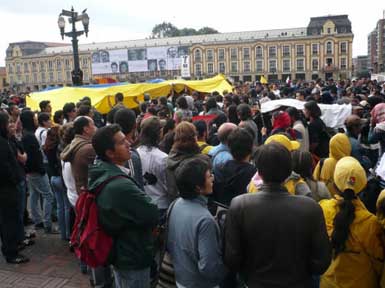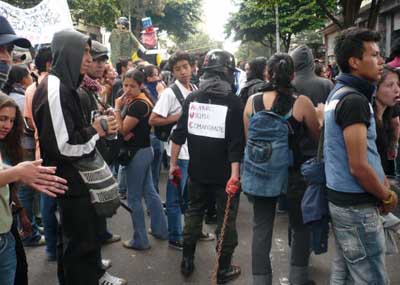On Saturday, March 1, the Colombian military invaded Ecuador in order to assassinate Raul Reyes, a key leader of the FARC, one of the guerilla organizations which have been fighting the Colombian government for decades.
As a result, the marches became a major, and totally unexpected, anti-war protest.
That protest was almost certainly one of the key factors which led to the retreat of the Colombian government from its war-like rhetoric the very next day, at the meeting of the Rio Group of countries in the Dominican Republic.
According to Semana magazine, no friend of the protest, 1,000,000 people marched. In addition to the main demonstrations in Colombia, solidarity marches were held in cities around the world. Some, like the one in Buenos Aires, Argentina, drew thousands of marchers. Others, like the ones in Washington D.C. and New York drew hundreds of marchers.
The marches had been planned months before by MOVICE (MOVIMIENTO DE VICTIMAS DE CRIMENES DE ESTADO – Movement of the Victims of State Crimes) and were backed by the major Colombian trade union organizations and the two opposition political parties: the Polo Democratico Alternativo (Democratic Alternative Pole) and the Partido Liberal (Liberal Party.)
Surprisingly, even some figures from the government backed the marches. Most important were the Procurador General (something like an Attorney General) Edgardo Maya Villazón, and the Fiscal General de la Nación, Mario Iguarán Aranand. (Both of these officials are involved in, and responsible for, the prosecution of the paramilitary organizations in Colombia, and for the prosecution of politicians connected to the paramilitary organizations.)
The official slogans for the march were, "POR LOS DESAPARECIDOS" (For the disappeared), "POR LOS DESPLAZADOS" (For the displaced), " POR LOS MASACRADOS" (For the massacred), and " POR LOS EJECUTADOS" (For the executed.)
The flavor of the demonstrations was somber, resilient, determined, and also humorous. Marchers carried tens of thousands of placards bearing the photos of people murdered, kidnapped and disappeared by the paramilitaries and the government – some pictures showing the most gruesomely tortured bodies of children and old people – others showing mass graves – but most just the faces of the dead and missing.
 Alongside of the placards were banners, street theater, and lots of chanting. Besides the official slogans there were many banners calling for a humanitarian exchange of prisoners between the government and the FARC, and opposing any effort by the government to rescue FARC hostages through military action. Sprinkled throughout the crowd were banners supporting Venezuelan President Hugo Chavez and Ecuadoran President Rafael Correa.
Alongside of the placards were banners, street theater, and lots of chanting. Besides the official slogans there were many banners calling for a humanitarian exchange of prisoners between the government and the FARC, and opposing any effort by the government to rescue FARC hostages through military action. Sprinkled throughout the crowd were banners supporting Venezuelan President Hugo Chavez and Ecuadoran President Rafael Correa.
What I heard the most were three chants, "Uribe paraca, la gente barraca." (The translation is more or less – Uribe paramilitary, the people are tough, resilient and mad!), "Uribe, Gonorea – La Gente esta con Correa (Uribe Gonorea, the people are with Correa!), and "Uribe fascista, Usted es terrorista!"
This march was smaller than the anti-FARC demonstrations a month earlier, but the conditions under which the marches took place were radically different.
The anti-FARC march had the blanket and total support of all mass media in Colombia, and of all major businesses and schools. It was a show of what the ruling class can mobilize when it pulls out all the stops, shuts the doors of businesses, closes schools, and advertises on page one for two weeks in advance.
The March 6th demonstrations were opposed by the government, threatened by the government and paramilitaries, and barely mentioned before hand in the press. The fact that 1,000,000 were brave enough to march despite this must have given pause to the Uribe government as it headed toward war with Venezuela and Ecuador.
In February, the men who marched wore suits and ties, and a lot of the ladies wore heels. A lot of those protestors were busy getting their visas in order in case of a war with Venezuela and Ecuador on March 6th. This no doubt explains why they did not have time to demonstrate against paramilitary violence.
Instead of the ladies in heels and the men in ties, the March 6th protests were led by women in blue jeans, carrying pictures of their children, brothers, sisters, and husbands who had been killed by the army and the paramilitaries. They were followed by high school and university students, by women and men from the factories, and by tens of thousands of displaced people. Very few people marched in high heels or suits and ties.
Despite the differences, one fact united most of the people who marched in the two opposed demonstrations. The people of Colombia are tired of war, and desperately want peace.
 This truth extends to the soldiers in the Colombian army who are drawn from amongst the poor – the people who demonstrated on March 6, and who by and large stayed home for the February anti-FARC demo.
This truth extends to the soldiers in the Colombian army who are drawn from amongst the poor – the people who demonstrated on March 6, and who by and large stayed home for the February anti-FARC demo.
Colombia’s President Alvaro Uribe Velez backed down at the Rio Group meeting, partly because he is deathly afraid of what will happen in Colombia if there really is a war with the country’s neighbors. But his retreat may only be temporary.
The offensive against the FARC has escalated, with the assassination of a second member of the FARC secretariat, Ivan Rios, and newspaper headlines calling for the assassination of Mono Jojoy (Jorge Briceño) the FARC’s military commander. The government of Colombia is offering "Dead or Alive" rewards from between $2,500,000 and $5,000,000 (US dollars) for FARC leaders. It monitors all FARC internet and electronic communications.
The Bush government is clearly unhappy about Uribe’s retreat from war. According to the Miami Herald and Nuevo Heraldo, they are now working on putting Venezuela on their list of "terrorist" governments along with Iran and North Korea. If this happens, it will almost certainly set the stage for a new round of conflicts here in the northwestern corner of South America.
Whatever happens next, the "other" Colombia has decided to step onto the stage as an actor against war, and against paramilitarism.
